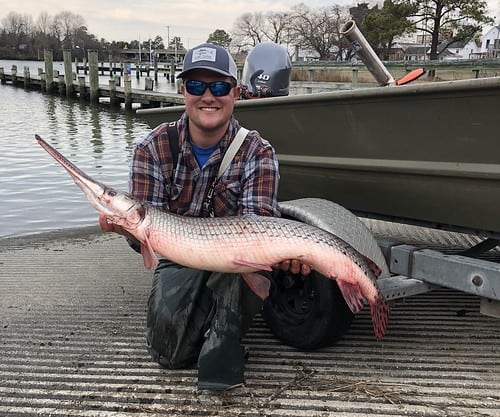Another state record dinosaur fish has been pulled from Marshyhope Creek on Maryland’s Eastern Shore, this one by Samson Matthews, 22, of Hurlock, Maryland. The 18.30-pound longnose gar has been certified as the new state record for that species in the Chesapeake Division, besting the 17.90 pounder set by David Confair of Secretary, MD in January of 2019. Confair was also fishing on Marshyhope Creek.
“I didn’t even know what it was at first,” Matthews told Maryland Department of Natural Resources.
On March 2, he was fishing with a friend above El Dorado Bridge, using cut gizzard (mud) shad for bait. After a 20-minute tussle, they hauled the fish on board, knowing it was a potential record fish. The gar was weighed at Kool Ice and Seafood in Cambridge, and after state biologists certified the species, Matthews released it back into the Marshyhope, just as Confair did last year with his prized fish.
Gars inhabit fresh and brackish tributaries throughout the Chesapeake watershed, preferring the stained, quiet waters of creeks and rivers, often lurking in weedy areas to ambush bait.
According to the Chesapeake Bay Program, the population status is stable. Gars have been around for 100 million years, well before the fish we’re most familiar with today even flipped a fin. They are relatively long-lived fish, from 17 to 20 years. Females obtain sexual maturity at age six, males at four years old.
Longnose gar’s scientific name, Lepisosteus, means “hard-scaled,” and because they’re a bony fish they aren’t really targeted as table fare. Physically they look prehistoric; a long, beak-like snout packed with sharp teeth, and a dark olive or brown cylindrical body decorated with diamond-shaped scales. Dark spots appear on their backs, fins and sides. They grow six feet long and can weigh up to 50 pounds. Females are generally larger than males. Longnose gars are also able to breathe air from the atmosphere, an evolutionary advantage especially useful when dissolved oxygen levels drop in summer months.
-Capt. Chris D. Dollar




